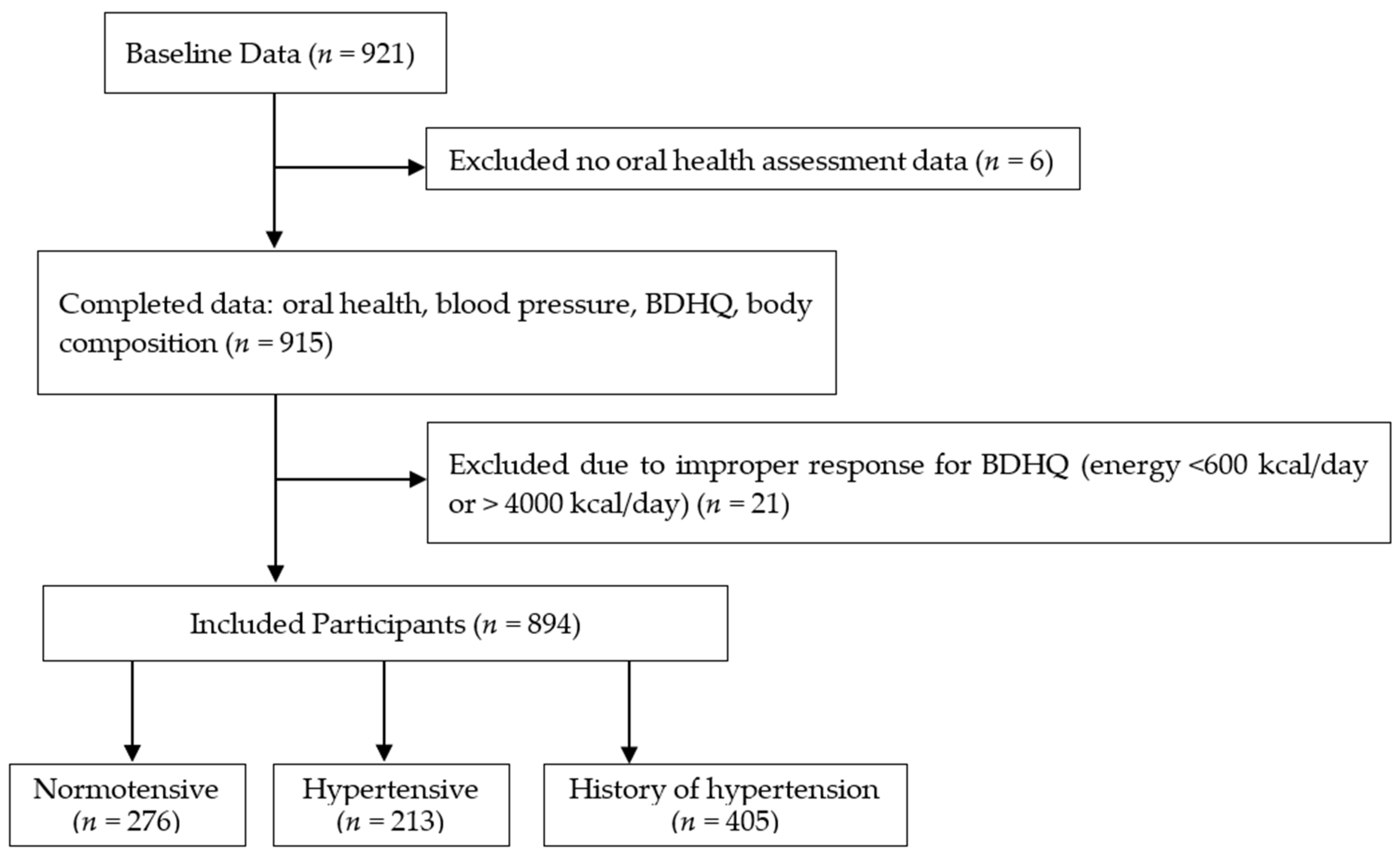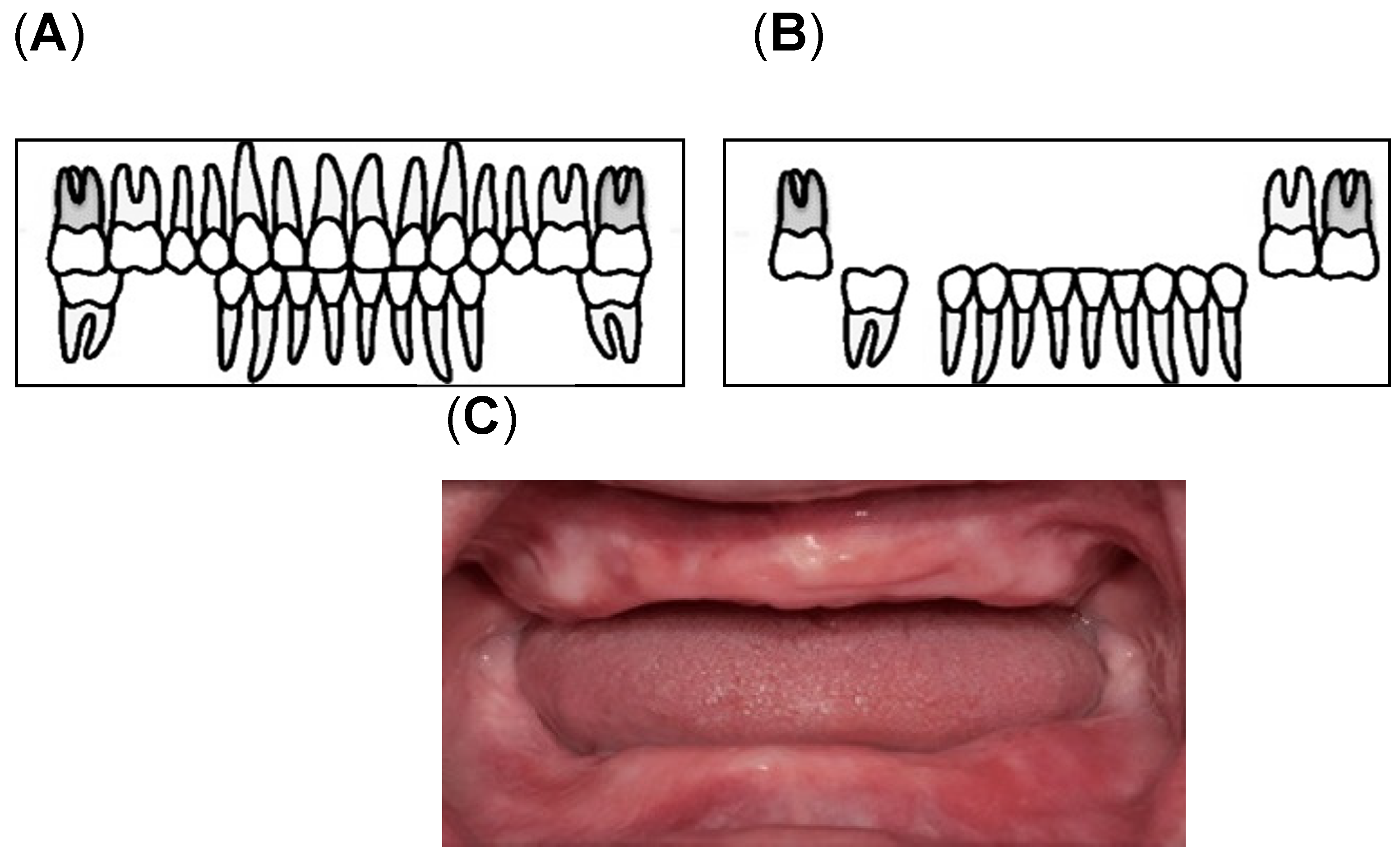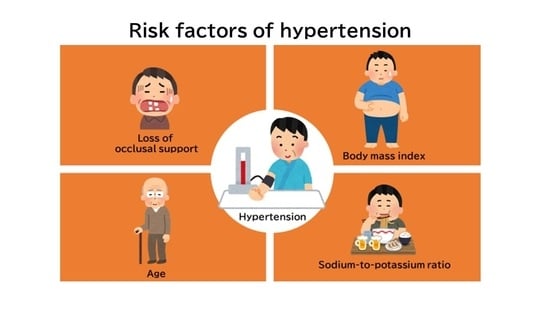1. Introduction
The prevalence of hypertension has more than doubled in the last 30 years, making it one of the leading causes of disease and mortality worldwide, with an estimated 1.28 billion people suffering from hypertension in 2019 [
1,
2]. Hypertension has become one of the leading causes of death in Japan among noncommunicable diseases [
3,
4]. Alarmingly, the number of people with hypertension in Japan is estimated to be 43 million [
1,
5], but only 50% received treatment, while 25% had controlled blood pressure (BP) [
5]. Furthermore, approximately 70% of older adult population (≥75 years) of Japan has hypertension [
6]. According to the Japan Society of Hypertension, individuals who are ≥ 75 years old with a BP ≥ 140/90 mmHg are considered hypertensive [
5]. Hypertension is a complex medical condition caused by several factors. Previous studies have identified that periodontal disease [
7], occlusal status [
8], and tooth loss [
8,
9,
10] are associated with hypertension. However, the role of oral health in hypertension is yet to be clarified. Identifying the risk factors for hypertension, even those with marginal risk, is crucial to devise strategies to prevent the development of hypertension and thus prevent cardiovascular disease. Several studies have reported that hypertension is associated with oral health, including impaired mastication, poor oral hygiene, and oral inflammation [
7,
9,
10,
11].
Oral health, which is an indicator of general health, can be affected by a range of diseases and conditions that include dental caries, periodontal disease, and tooth loss [
12]. Teeth and oral function constitute the main pathways considered vital in connecting oral to general health. According to the Health 21 plan of Japan, improvement of oral function is the primary target for older adults [
13], and the number of teeth has been long established as one of the indicators of the oral health condition [
14]. According to the Japan Dental Diseases Survey in 2016, approximately 280,000 and 100,000 patients were estimated to have minor (1–8 missing teeth in one jaw) and major (9–14 missing teeth in one jaw) tooth loss, respectively [
15]. Further, adults (≥75 years) lose a minimum of ten teeth per year [
16]. A study has reported that tooth loss, particularly in older adults, was associated with malnutrition [
17]. Tooth loss invariably leads to the decline of mastication ability, changes in food selection and dietary intake, and changes in nutrient intake, all of which, consequently, have an adverse effect on general health, increasing the risk of systemic diseases, frailty, and mortality [
17,
18,
19,
20,
21,
22].
As oral and general health decline with aging and disease(s) [
20,
21,
23,
24,
25,
26], the number of unchewable food particles increases over time, leading to changes in food selection and eating habits [
19,
23,
24]. According to the 2018 National Health Nutrition Survey in Japan, approximately 25% of people (≥60 years of age) reported a decline in masticatory function, which implies that they were unable to chew a variety of food [
13]. Mastication is the first step of the digestive process of breaking food into smaller particles for swallowing that allows more nutrient absorption, which is essential for the maintenance of health, especially in older adults [
24,
27]. Numerous studies have reported that masticatory function is influenced by several factors, such as the number of remaining teeth [
21,
28], posterior occlusal contact [
21,
29,
30], occlusal force [
21,
30], salivary secretion [
28,
30], and tongue function [
28,
31]. Tooth loss influences an individual’s food choice and dietary intake, leading to maladaptive behaviors. For example, an individual with tooth loss will prefer eating soft and easy-to-chew foods [
32], and will avoid fiber-rich and nutrient-dense foods, such as raw fruits and vegetables, nuts, meats, and grain products, thereby increasing fat, sugar, other carbohydrates, and processed food consumption [
32,
33].
To measure an individual′s usual food consumption and dietary intake, a food frequency questionnaire can be utilized. Food questionnaires have become one of the main research tools in nutritional epidemiology [
34]. In Japan, Sasaki et al. [
35] developed a brief self-administered diet history questionnaire (BDHQ) to assess the Japanese diet, which uses food frequency and dietary history. The BDHQ is a validated food frequency questionnaire that estimates the dietary intake of 58 food and beverage items during the preceding month. It consists of the following five sections: intake frequency of food and non-alcoholic beverages, daily intake of rice and miso soup, frequency of drinking alcoholic beverages and amount per drink for five alcoholic beverages, usual cooking methods, and general dietary behaviors [
35,
36,
37]. The food and beverage items included in the questionnaire were mainly from a food list used in Japan′s National Health and Nutrition Survey, which is based on foods commonly consumed in Japan [
35].
It is widely established that there are relationships between nutrition and hypertension [
38,
39,
40], and between oral health and hypertension [
7,
8,
9,
10,
41]. A study by Fushida et al. [
41] elucidated the link between high BP and decreased masticatory performance; however, their study did not assess the role of oral health in nutrition. As stated by the authors, a non-direct causal relationship was assumed between high BP and decreased masticatory ability [
41]. Nutritional status is expected to be very strongly associated with the relationship between high BP and decreased masticatory performance, among several other expected confounding factors [
8,
41]. Therefore, the authors felt the need to investigate further the association of oral health with hypertension, indirectly, by assessing nutrition, to better understand the cardiovascular demographics in older adults.
The authors hypothesized that impaired oral health can cause nutritional imbalances, which might affect blood pressure. Hence, in this study, we aimed to investigate the dietary intake of the Japanese older adult population to clarify the role of oral health in nutrition and hypertension.
4. Discussion
In this study, we aimed to assess the role of oral health in nutrition and hypertension by exploring dietary intakes in a Japanese older adult population. Impaired mastication makes an individual more susceptible to developing systemic diseases that could lead to frailty and mortality when not addressed properly. Among the participants in this study, 45.3% had a history of hypertension, with the majority being females (64.4%), older, and having a higher BMI, higher alcohol consumption, exercise and smoking habits, comorbidity diseases such as diabetes mellitus, dyslipidemia, chronic kidney disease, cardiovascular disease (CVD), stroke, having a lower number of remaining teeth, loss of posterior occlusal contact, decreased occlusal force, lower oral moisture count, lower masticatory performance, lower intake of green and yellow vegetables, β-carotene, vitamin K, and high sodium-to-potassium ratio. This study showed that age was the only factor significantly associated with β-carotene, vitamin K, green and yellow vegetables, and meat, while the sodium-to-potassium ratio barely correlated with the remaining teeth and masticatory performance. Furthermore, significant explanatory variables affecting hypertension among the participants were BMI, age, sodium-to-potassium ratio, and the absence of posterior occlusal contact. According to prior findings, periodontal disease can affect the number of remaining teeth [
10]. Decrease in posterior occlusal contact can lead to a decline in mastication ability [
17]. Since mastication is an essential function for ingestion and digestion, a decline in mastication ability induces many functional declines, including malnutrition. If problems pertaining to nutrition are not addressed appropriately, it could lead to systemic issues, such as hypertension [
17]. The results of our study postulate that decreased posterior occlusal contact possibly restricts individuals to chew foods, such as green and yellow vegetables, thus consequently decreasing dietary fiber intake, leading to low potassium and high sodium intake, which are risk factors for developing hypertension. The study findings suggest that maintaining good oral health is important to improve nutritional intake and prevent hypertension. To our knowledge, this is the first study that acknowledged oral health as another contributing factor in the development of high BP by examining the dietary intakes of the older adult in the Japanese population.
4.1. The Role of Oral Health in Nutrition and Hypertension
The findings of this study revealed that the risk of hypertension increased with age, which was consistent with previous reports [
5,
16]. The study also revealed that in older adults, the absence of posterior occlusal contact increased the risk of hypertension by 1.7 times. The loss of occlusal contact results in a decrease in mastication ability [
17]. Thus, this study postulates that the participants in the History of hypertension group were found to have a lower masticatory performance because they had lower oral moisture count, decreased occlusal force, no posterior occlusal contact, and a lesser number of remaining teeth. Tooth loss can lead to hyperactivity of the masticatory system, leading to unhealthy diet patterns and reduced nutrient intake that can negatively influence the general health [
58]. Studies have reported that tooth loss was directly related to reduced oral function [
17]. Hence, the Japan Ministry of Health, Labor, and Welfare continuously promotes preserving ≥ 20 natural teeth until the age of 80 [
58] because tooth loss can decrease posterior occlusal contact, consequently influencing the occlusal force [
59]. Reduced occlusal force affects saliva secretion, which is necessary for oral functions such as mastication and swallowing. Other factors such as systemic diseases and medications can influence saliva secretion [
17,
60]. Hasegawa et al., found that the patients taking antihypertensive drugs have decreased saliva secretion [
60]. Dry mouth is a common side effect of antihypertensive medication, which could deteriorate teeth and periodontal condition [
49], eventually leading to tooth loss if not addressed properly. In this study, the participants were found to be taking calcium channel blockers (CCBs), renin–angiotensin system inhibitors (angiotensin II receptor blockers (ARBs), angiotensin-converting enzyme (ACE) inhibitors), aldosterone receptor antagonists, β-blockers, and α-blockers. Moreover, there were several participants who took two combinations of medication. It was reported that the masticatory ability was influenced by the number of natural teeth, occlusal support, muscular weakness, and occlusal force [
23].
Mastication is a necessary function for nutrition-ingestion, and an impaired mastication ability leads to many functional declines, including malnutrition [
17]. Several observational studies have revealed that tooth loss, particularly in older adults, was associated with dietary intake of fruits and vegetables and a low intake of antioxidative vitamins. Furthermore, the low occlusal force has been linked to a decrease in vegetable, fruit, antioxidant, and dietary fiber intake [
23]. The present study presumed that the individuals without posterior occlusal contact prefer foods that are easy to chew and avoid vegetables high in potassium, which was consistent with a study finding that Japanese older adults with <19 teeth had a significantly lower intake of vegetables than those with ≥20 [
61]. This was also consistent with the findings of our study that the participants in the History of hypertension group had the lowest intake of potassium. According to the JSH 2019 guidelines, improving dietary patterns, such as increasing fruit and vegetable intakes (to 350 g/day), can reduce the risk of hypertension because potassium antagonizes the hypertensive activity of the sodium [
5]. It was also pointed out that balanced ingestion of fruits and vegetables (especially green and yellow vegetables) may be necessary for improved general health [
17].
4.2. Other Factors Related to Hypertension
Our findings also revealed that the participants with a higher intake of sodium-to-potassium ratio had 1.7 times higher risk of developing hypertension, which confers with the report of Park et al. [
40] that sodium-to-potassium ratio and blood pressure were strongly correlated. Moreover, participants in the Hypertensive group had the highest intake of sodium (Na) and salt (NaCl), 5082.4 mg/day and 12.8 g/day, respectively, which was higher than the Japanese Society of Hypertension′s recommendation of 6.0 g/day for hypertensive individuals [
5]. However, because the BDHQ was designed to evaluate Japanese dietary habits and was not specific for sodium intake, we were unable to establish the relationship between salt intake, sodium intake, and hypertension in this study [
57]. The current study considered that the easy-to-chew foods preferred by the older Japanese adults were processed foods with high salt content [
5]. It was previously reported that the high salt intake increases BP, and excessive salt intake was one of the possible causes for the high prevalence of hypertension and stroke in Japan [
5,
62]. Furthermore, we also found that even if the participants in this study had a normal BMI, their BP was still higher, which was consistent with the report of the JSH 2019 that the hypertensive Japanese are often free of obesity [
5]. The results of our study also suggested that the participants with a higher BMI were 1.2 times more likely to develop hypertension and/or need BP control, which was also agreeing with the JSH 2019 report that population risk for cardiovascular diseases was higher in hypertensive non-obese individuals than that in the hypertensive obese individuals [
5].
Hence, the Japanese government conducted mass media-mediated public education, obligated food manufacturers to indicate salt content in food packaging, promoted nutritional labeling in school lunch/food service industries, distributed home blood pressure measurements, and required all allied health professionals to instruct patients including non-hypertensive individuals to improve their lifestyle including the balanced dietary intake, improved oral hygiene, increased physical activities (approximately 1500 step increase in the number of steps), and maintain moderate alcohol consumption. Furthermore, the Japanese government provided home-visit dental services to promote the oral health of dependent older adults and covered dental care as part of its universal health coverage [
5,
13]. These strategies are required to achieve the goals of reducing hypertension, CVD morbidity/mortality, and extending the healthy life expectancy of Japanese individuals.
4.3. Limitation
Several limitations must be considered when interpreting the findings of this study. First, there might have been an underestimation or overestimation of dietary intake because the BDHQ is a self-report survey designed to evaluate Japanese dietary patterns, habitual intake, cooking, and seasoning, which did not reflect the quantity of selected foods [
63]. Second, the sodium-to-potassium ratio was not calculated using the urine analysis [
57]. Third, we failed to find a relationship between education and living arrangements with the hypertension risk because highly educated individuals may be more knowledgeable about choosing healthy food [
64], while individuals who eat alone might choose a quick and simple meal rather than a nutritionally balanced diet [
65]. This might happen because we evaluated them based on their educational years rather than the educational level. Lastly, no causal relationships among dietary intake, oral health, and hypertension were established because of the observational design of the study. Hence, further studies should be conducted in the future to elucidate more on the role of oral health in nutrition.
4.4. Clinical Implications
Given the significance of oral health in the nutritional status and general health of older adults, preserving remaining teeth and improving masticatory performance is critical. This study provided evidence that decreased posterior occlusal contact increases the risk of hypertension by 1.7 times. Hence, oral rehabilitation with dentures to maintain posterior occlusal contact may be recommended for improved masticatory performance, improved dietary intake, and a lower risk of hypertension. The findings of this study will also raise awareness about lifestyle changes that can reduce the risk of hypertension, such as lower salt intake, higher fruit and vegetable intake, maintaining a healthy weight, increasing exercise habits, decreasing smoking habits, and reducing alcohol consumption.










